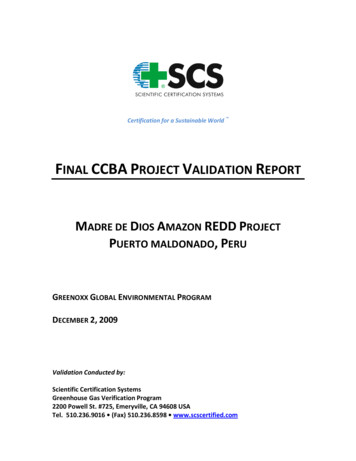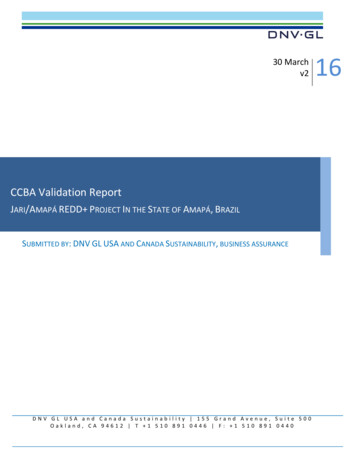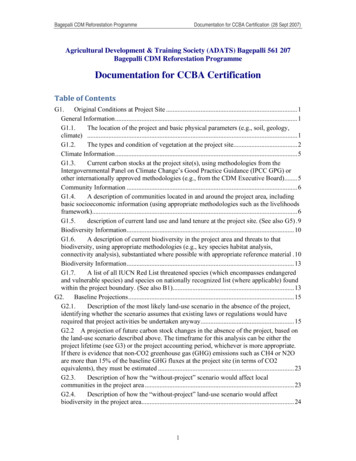
Transcription
CCBAPROJECT DESIGN DOCUMENT FORM FOR PROJECT ACTIVITIES (CCBA-PDD)Version 02CONTENTSI.Basic DataII.General SectionG1. Original Condition of Project SiteG2. Baseline ProjectionsG3. Project Design & GoalsG4. Management CapacityG5. Legal Status and Property RightsIII.Climate SectionCL1. Net Positive Climate ImpactsCL2. Offsite Climate Impacts (“Leakage”)CL3. Climate Impact MonitoringIV.Community SectionCM1. Net Positive Community ImpactsCM2. Offsite Community ImpactsCM3. Community Impact MonitoringV.Biodiversity SectionB1. Net Positive Biodiversity ImpactsB2. Offsite Biodiversity ImpactsB3. Biodiversity Impact MonitoringVI.Gold LevelGL1. Climate Change Adaptation BenefitsGL2. Exceptional Community BenefitsGL3. Exceptional Biodiversity Benefits1
CCBAPROJECT DESIGN DOCUMENT FORM FOR PROJECT ACTIVITIES (CCBA-PDD)Version 02I. Basic Data:1) The title of the CCB Standards project activity:Restoration of degraded areas and reforestation in Cáceres (Caceres (Antioquia)) andCravo Norte (Cravo Norte (Arauca)), Colombia2) The version number of the document:Version I3) The date of the document:29 September, 2010II. General Section:G1 Original Conditions at Project Site (Required)G.1.1 Describe the location of the project and basic physical parameters (e.g., soil,geology, climate).Location: The project is located in two different Departments of Colombia. The first site islocated in Cáceres Municipality in the Department of Antioquia. The second site is locatedin Cravo Norte Municipality in the Department of Arauca. Throughout this document thefirst project site will be referred to as “Cacares (Antioquia)” and the second as “CravoNorte (Arauca).”Figures 1-4 below illustrate the location of each farm on political and geographical mapsrespectively.2
CCBAPROJECT DESIGN DOCUMENT FORM FOR PROJECT ACTIVITIES (CCBA-PDD)Version 02Figure 1. Situational map of project area Caceres (Antioquia)3
CCBAPROJECT DESIGN DOCUMENT FORM FOR PROJECT ACTIVITIES (CCBA-PDD)Version 02Figure 2.Situational map of project area Cravo Norte (Arauca)Figure 3. Caceres (Antioquia) project parcel location4
CCBAPROJECT DESIGN DOCUMENT FORM FOR PROJECT ACTIVITIES (CCBA-PDD)Version 02Figure 4. Cravo Norte (Arauca) project parcel locationHydrology: Caceres (Antioquia): several sub-basins of the Cauca River are located within theterritory including the sub-basins of the rivers Man, Corrales, Tamaná andstreams Nicapá, Agua Linda and La Magdalena, among others. These waterwaysprovide water to the municipality and the counties Jardín and Puerto Belgium.1 Cravo Norte (Arauca): in this area the hydrographic network is extensive. Thewhole river system empties in the west-east direction to the Orinoco river throughthe rivers Cravo Norte, Casanare, Meta, Vichada, Guaviare and Tomo, whichcollect water from other tributaries of importance in the department of Arauca,such as Tocoragua, Tame, Cravo Norte, Ele, Lipa, San Miguel and all NegroCimaruco. The El Medio and Cumare pipes, tributaries of the Casanare River, areimportant means of transport in the region.2Climate: Caceres (Antioquia): this region experiences a summer season from November toMarch, and winter from March to November. During the wet season rainfallreaches up to 82.3% of the annual total.3 The predominant climate in the region iswarm. The average temperature is 28 º C with varying fluctuations in the range of4 º C. The most dramatic temperature variations occur in the early hours of theday, with temperatures as low as 20 º C, and at noon, with temperatures as highas 32 º C. Cravo Norte (Arauca): this area falls into the category of dry or seasonalgrasslands. The climatic conditions alternate annually between a wet season withhigh availability of water in the soil (6-9 months) and another, more or lessprolonged, season characterized by a deficiency or decrease in water soilsubstrate. The rainfall record describes a unimodal curve.4 The highest rainfalloccurs between April and November. December and March have low rainfallbecause the northeast trade winds prevent the formation of clouds in the region.When it rains the intensity is high, thus, water erosion is a common degradationprocess in the region. The average annual precipitation is 1,532 mm.5 The1Gonzalez F. Á. and A. Cortes. “Suelos del departamento de Caceres (Antioquia). Tomo I: Departamento deCaceres (Antioquia) y su aptitud de uso. Instituto Geográfico” “Agustín Codazzi” (IGAC). Bogotá DC (1979).2Corporación Nacional De Investigación y Fomento Forestal (CONIF), Ministerio Del Medio Ambiente,Organización Internacional De Mderas Tropicales (OIMT). “Guía para plantaciones forestales comercialesOrinoquía. Serie de documentación No. 38.” Santafé de Bogotá (1998); Corporación Autónoma Regional dela Orinoquía (CORPORINOQUÍA). “Plan de Acción 2004-2006.” Yopal, Cravo Norte (Arauca) (2004).(http://corporinoquia.gov.co)3Agudelo et. al. “Estudios en Rastrojeras incentivadas del Municipio de Cáceres.” Universidad Nacional deColombia, Departamento de Ciencias Forestales. Corporación Autónoma Regional del Centro de Caceres(Antioquia) (CORCACERES (ANTIOQUIA)). (2000); Gonzalez F. Á. and A. Cortes. “Suelos del departamentode Caceres (Antioquia). Tomo I: Departamento de Caceres (Antioquia) y su aptitud de uso. InstitutoGeográfico” “Agustín Codazzi” (IGAC). Bogotá DC (1979).4Rippstein, G., G. Escobar, F. Motta.(Eds.) “Agroecología y Biodiversidad de las sabanas de los llanosorientales de Colombia.” Centro Internacional de Agricultura Tropical (CIAT), (2001).5Corporación Autónoma Regional de la Orinoquía (CORPORINOQUÍA). “Plan de Acción 2004-2006.” Yopal,Cravo Norte (Arauca) (2004). (http://corporinoquia.gov.co)5
CCBAPROJECT DESIGN DOCUMENT FORM FOR PROJECT ACTIVITIES (CCBA-PDD)Version 02average annual temperature is 26.1 C, the maximum value (36.4 º C) occursduring March and minimum (18.6 º C) during January.Soil and Topography: Caceres (Antioquia): the terrain is made up of terraces, some of which aredissected as well as relief with sloping areas that are flat on top. In general thesoils are from two textural families: fine with clay loam or clay skeletal, whichexceed 50% of particles with diameters larger than 2 mm. Layers of pebbles existup until one meter of depth, Structural development is regular with dark colors onthe surface and brown and yellowish-red in the subsoil, which may have spots inthe lower horizons. The area in Cáceres (Oxic Dystropept) consists of soilslocated in the oldest terraces, which are located in the high and intermediatelevels. These are moderately deep and are limited by chemical factors or by thepresence of gravel in the profile and are generally well drained. Fertility variesfrom low to very low, the reaction ranges from very strong to strongly acidic. Thecation exchange capacity is between medium and low; total bases range from lowto very low; the base saturation is medium to low; the organic carbon decreasesregularly from high to very low; phosphorus is low. Aluminum reaches toxic levelsfor plants near the surface.6 Cravo Norte (Arauca): the area consists of fluvial terraces and floodplains, whichextend from the foothills of the eastern cordillera of the Andes to beyond theborder with the Republic of Venezuela. Soils vary from very superficial tomoderately deep, limited by stoniness. Textures are loamy sand, with quartz asthe dominant material, mainly in the coarse fraction. They have moderate contentsof organic matter; moderate to low cation exchange capacity; and are low incalcium, magnesium, potassium and phosphorous. The active aluminum contentis high and fertility ranges from low to very low. Aluminum is the main componentof the soil’s exchangeable acidity, being one of the main factors contributing topoor plant growth. The pH values below 5.5 reduces crop growth by the presenceof toxic amounts of aluminum.7G.1.2 Describe the types and condition of vegetation at the project site:The predominant vegetation at the project sites both in Caceres (Antioquia) and CravoNorte (Arauca) is grassland. In Caceres (Antioquia) primary forest was felled decadesago to create grassland, which has been used over the past few decades for extensivecattle grazing or for gold mining. In Cravo Norte (Arauca) the grassland is part of naturalsavannahs. At both project sites there are some isolated trees and shrubs, howeverthese will not be removed in order to carry out the project activity. Any existing stands offorest or natural regeneration have been excluded from the project area and will not beaffected.6Agudelo et. al. “Estudios en Rastrojeras incentivadas del Municipio de Cáceres.” Universidad Nacional deColombia, Departamento de Ciencias Forestales. Corporación Autónoma Regional del Centro de Caceres(Antioquia) (CORCACERES (ANTIOQUIA)). (2000); Gonzalez F. Á. and A. Cortes. “Suelos del departamentode Caceres (Antioquia). Tomo I: Departamento de Caceres (Antioquia) y su aptitud de uso. InstitutoGeográfico” “Agustín Codazzi” (IGAC). Bogotá DC (1979).7Corporación Nacional De Investigación y Fomento Forestal (CONIF), Ministerio Del Medio Ambiente,Organización Internacional De Mderas Tropicales (OIMT). “Guía para plantaciones forestales comercialesOrinoquía. Serie de documentación No. 38.” Santafé de Bogotá (1998)6
CCBAPROJECT DESIGN DOCUMENT FORM FOR PROJECT ACTIVITIES (CCBA-PDD)Version 02The principle species of grass found in project sites in Caceres (Antioquia) areHyparrenia Ruffa, Briachiara, Andropogum guayanus, Panicum maximum, Digitariadecumbens, Dichanthium aristatum, Brachiaria mutica and Echynochloa polystachya.8The principle species of grass found in project sites in Cravo Norte (Arauca) areHyparrhenia rufa, Melinis minutiflora, Paspalum plicatulum and Briachiara decumbens, aparticularly aggressive non-native grass introduced for cattle grazing purposes because itis highly adaptable and has a higher yield.9In the case of Cravo Norte (Arauca), gallery forests occur in some areas close to theplantation. Gallery forests are evergreen forests that form as corridors along rivers orwetlands and project into landscapes that are otherwise only sparsely covered with trees,such as savannas, grasslands or deserts. Gallery forests are able to exist where thesurrounding landscape does not support forests. The project takes place in a savannaharea where the natural conditions allow for almost no forest cover. Furthermore, the landshave been subjected to annual fires originating from anthropogenic activities, or naturalcauses.G.1.3 Boundaries of the project area and the project zoneTable 1:NameCaceres ICaceres IIBoundary coordinates for location of project areaLatitude7º 36' 20.36"7º 36' 13.72"7º 36' 12.857º 36' 00.54"7º 35' 53.61"7º 35' 46.73"7º 35' 32.75"7º 35' 37.62"7º 35' 33.51"7º 35' 35.87"7º 35' 30.44"7º 35' 26.19"7º 35' 21.25"7º 35' 41.71"7º 35' 38.97"7º 35' 50.14"7º 36' 04.47"7º 36' 14.74"7º 36' 08.84"7º 36' 16.60"7 36 18.28''7 36 14.43''7 35 01.896''7 34 49.738''7 34 53.901''7 34 42.615''Longitude75º 17' 54.96"75º 18' 08.04"75º 18' 02.00"75º 17' 55.64"75º 18' 04.60"75º 18' 00.17"75º 18' 09.40"75º 18' 01.76"75º 18' 01.16"75º 17' 57.34"75º 17' 57.62"75º 17' 54.37"75º 17' 34.05"75º 17' 16.89"75º 16' 58.64"75º 16' 52.35"75º 17' 14.46"75º 17' 17.13"75º 17' 25.36"75º 17' 32.59"75 19 35.41''75 19 46.25''75 20 40.214''75 20 32.554''75 20 27.309''75 20 06.736''NameFinca El EspirituSantoFinca LaMagdalenaFinca La MariaFinca La TrinidadFinca San MartinLatitude70 20'01,18''70 20'45,22''70 21'05,53''70 21'33,79''70 21'43,51''70 21'57,82''70 22'39,79''70 21'57,16''70 21'25,75''70 20'39,34''70 21'33,79''70 21'43,51''70 22'50,10''70 22'36,52''70 21'19,49''70 21'26,55''70 19'55,863"W70 19'18,211"W70 19'2,261"W70 21'24,764"W70 21'27,64"W70 20'13,251"W70 19'55,814"W70 21'27,753"W70 22'8,563"W70 21'43,51''Longitude6 24'28,39''6 24'49,63''6 24'59,43''6 25'12,69''6 24'52,68''6 24'13,58''6 23'33,53''6 22'54,16''6 23'20,55''6 23'57,78''6 25'12,69''6 24'52,68''6 25'34,08''6 26'28,29''6 26'51,26''6 26'02,62''6 23'35,297"N6 23'19,347"N6 22'12,933"N6 21'22,626"N6 22'1,062"N6 24'37,605"N6 23'35,374"N6 22'1,572"N6 23'2,582"N6 24'52,68''8Moscoso, L. G. Reforestación, un proceso natural. Eurotex. Editorial Colina, (2005).Corporación Autónoma Regional de la Orinoquía (CORPORINOQUÍA). “Plan de Acción 2004-2006.” Yopal,Cravo Norte (Arauca) (2004). (http://corporinoquia.gov.co)97
CCBAPROJECT DESIGN DOCUMENT FORM FOR PROJECT ACTIVITIES (CCBA-PDD)Version 02Caceres IIICaceres IV7 34 36.869''7 34 33.976''7 34 13.36''7 34 41.05''7 34 55.521''7 35 05.373''7 35 17.568''7 35 25.143''7 35 31.045''7 35 46.822''7º 35' 35.23"7º 35' 32.02"7º 35' 27.04"7º 35' 12.74"7 º35' 08.88"7º 35' 06.30"7º 34' 55.77"7º 34' 48.14"7º 34' 51.83"7º 34' 51.54"7º 34' 48.59"7º 34' 45.43"7º 34' 50.01"7º 34' 52.98"7º 34' 52.87"7º 34' 58.12"7º 35' 03.87"7º 35' 08.44"7º 35' 11.42"7º 35' 11.81"7º 35' 09.72"7º 35' 19.83"7º 35' 23.01"7º 35' 24.61"7º 35' 28.89"7 36'17,023"N7 36'27,611"N7 36'35,49"N7 36'36,061"N7 36'39,751"N7 36'33,85"N7 36'24,517"N7 36'19,633"N7 36'13,831"N7 36'16,847"N7 36'11,031"N7 36'1,348"N7 35'58,199"N7 35'54,596"N7 35'54,597"N7 35'49,638"N7 35'44,361"N7 35'39,493"N7 35'39,588"N7 35'37,75"N7 35'37,266"N7 35'34,387"N7 35'34,903"N7 35'39,611"N7 35'43,399"N7 35'47,504"N7 35'58,61"N75 20 10.876''75 19 58.641''75 19 31.984''75 19 21.763''75 19 13.175''75 19 01.021''75 19 19.159''75 19 12.725''75 19 12.078''75 19 11.777''75º 14' 52.21"75º 15' 04.14"75º 15' 13.38"75 º15' 13.14"75º 15' 09.25"75º 15' 9.24"75º 15' 11.90"75º 15' 06.41"75º 15' 02.04"75º 14' 57.76"75º 14' 48.70"75º 14' 42.03"75º 14' 35.77"75º 14' 39.86"75º 14' 42.05"75º 14' 48.92"75º 14' 48.84"75º 14' 50.25"75º 14' 48.86"75º 14' 50.35"75º 14' 53.53"75º 14' 57.34"75º 14' 55.66"75º 14' 52.68"75º 14' 49.70"75 12'39,638"W75 12'37,73"W75 12'43,979"W75 12'50,631"W75 12'52,577"W75 13'0,811"W75 13'4,743"W75 13'9,192"W75 13'11,702"W75 13'14,74"W75 13'22,469"W75 13'18,908"W75 13'15,112"W75 13'11,904"W75 13'11,735"W75 13'13,069"W75 13'7,163"W75 13'5,887"W75 13'1,763"W75 12'57,97"W75 12'50,224"W75 12'44,156"W75 12'39,444"W75 12'37,857"W75 12'34,668"W75 12'38,466"W75 12'31,509"WFinca MacanillaFinca MatecorozoFinca BetaniaFinca 3213 Has70 22'28,12''70 22'45,48''70 23'09,68''70 23'37,91''70 23'00,60''70 22'39,79''70 21'57,82''70 14'27,57''70 14'29,06''70 14'36,19''70 14'22,23''70 14'07,01''70 14'09,93''70 14'15,66''70 14'34,93''70 15'15,83''70 15'32,61''70 15'44,52''70 15'46,65''70 15'44,84''70 15'50,99''70 15'33,52''70 15'25,76''70 15'10,42''70 14'54,17''70 14'42,57''70 14'18,21''70 14'20,05''70 14'31,32''70 14'15,66''70 14'10,98''70 13'34,02''70 13'49,19''70 14'02,55''70 14'12,88''70 14'22,77''70 14'34,93''70 14'31,32''70 14'20,05''70 14'18,21''70 13'34,02''70 13'25,02''70 13'30,79''70 13'39,50''70 13'47,84''70 13'59,67''70 14'03,37''70 14'09,43''70 14'12,88''70 14'02,55''70 13'49,19''70 14'54,46''70 15'17,64''70 16'00,53''70 16'20,08''70 16'31,81''70 16'51,57''70 17'30,58''70 17'54,65''70 18'11,93''70 18'19,02''70 18'25,23''6 25'20,42''6 24'54,60''6 24'17,45''6 23'36,58''6 23'13,45''6 23'33,53''6 24'13,58''6 22'53,80''6 22'31,32''6 22'25,63''6 22'12,01''6 21'57,17''6 21'50,59''6 21'37,65''6 20'54,09''6 20'57,06''6 20'58,28''6 21'15,79''6 21'19,78''6 21'26,00''6 21'41,65''6 21'38,26''6 21'47,41''6 22'05,49''6 22'24,64''6 22'38,32''6 21'31,87''6 21'27,71''6 21'02,29''6 21'37,65''6 21'34,02''6 20'56,94''6 20'44,29''6 20'33,08''6 20'24,42''6 20'47,22''6 20'54,09''6 21'02,29''6 21'27,71''6 21'31,87''6 20'56,94''6 20'45,30''6 20'35,37''6 20'20,30''6 20'05,86''6 20'11,50''6 20'18,47''6 20'22,48''6 20'24,42''6 20'33,08''6 20'44,29''6 22'24,32''6 22'44,45''6 23'00,69''6 23'46,15''6 23'43,44''6 23'54,01''6 23'48,13''6 23'19,64''6 23'19,44''6 23'08,97''6 22'43,49''8
CCBAPROJECT DESIGN DOCUMENT FORM FOR PROJECT ACTIVITIES (CCBA-PDD)Version 02Caceres VIIFinca El EspejoFinca Sol Naciente7 36'1,449"N7 36'5,628"N7 36'12,08"N7 44'7,668"N7 44'25,069"N7 44'13,674"N7 44'1,918"N7 43'53,21"N7 43'38,816"N7 43'30,916"N7 43'25,663"N7 43'12,906"N7 43'13,49"N7 43'9,417"N7 43'1,708"N7 42'54,02"N7 42'45,955"N7 42'49,416"N7 42'56,117"N7 43'0,798"N7 42'58,371"N7 43'20,67"N7 43'36,274"N7 43'49,847"N7 44'1,195"N70 18'20,97"W70 18'23,404"W70 20'24,711"W70 21'25,846"W70 20'12,804"W70 20'47,913"W70 21'18,205"W70 21'45,934"W70 21'32,268"W75 12'37,914"W75 12'41,797"W75 12'47,622"W75 14'59,755"W75 15'14,442"W75 15'28,236"W75 15'25,764"W75 15'21,063"W75 15'18,99"W75 15'15,715"W75 15'8,382"W75 15'1,23"W75 15'10,178"W75 15'16,063"W75 15'17,058"W75 15'10,124"W75 14'53,024"W75 14'47,951"W75 14'45,123"W75 14'38,833"W75 14'36,387"W75 14'40,107"W75 14'44,623"W75 14'50,15"W75 14'53,637"W6 21'55,972"N6 20'40,592"N6 20'26,393"N6 21'23,385"N6 27'23,955"N6 26'31,614"N6 25'9,773"N6 25'22,997"N6 27'1,516"NFinca ChaparralFinca Berraquera70 18'10,71''70 18'07,23''70 18'08,73''70 18'11,78''70 16'32,09''70 15'23,99''70 15'32,61''70 15'44,84''70 15'50,99''70 15'33,52''70 21'16,52''70 21'36,97''70 21'51,55''70 21'55,10''70 22'10,80''70 22'20,36''70 23'24,64''70 22'20,01''70 21'29,83''70 21'22,78''70 18'26,42''70 18'19,02''70 18'25,23''70 18'10,71''70 18'07,23''70 18'07,09''70 18'15,71''70 18'31,02''70 18'44,53''70 19'03,94''70 18'45,67''6 22'26,42''6 21'57,23''6 21'18,32''6 20'30,14''6 20'14,32''6 20'17,63''6 20'58,28''6 21'26,00''6 21'41,65''6 21'38,26''6 22'05,97''6 22'30,73''6 22'48,37''6 22'44,14''6 22'25,16''6 22'14,07''6 20'57,53''6 20'21,52''6 20'51,62''6 21'19,27''6 23'24,00''6 23'08,97''6 22'43,49''6 22'26,42''6 21'57,23''6 21'44,23''6 21'43,33''6 21'41,73''6 21'40,32''6 23'00,33''6 23'21,53''G.1.4 Current carbon stocks at the project site(s), using methodologies from theIntergovernmental Panel on Climate Change’s Good Practice Guidance (IPCCGPG) or other internationally approved methodologies (e.g. from the CDMExecutive Board):The existing carbon stocks have been calculated in accordance with the approvedmethodology AR-AM0005 for CDM project activity. The land use under the baselinescenario is grassland. Added will be the case of Cáceres (Antioquia) with areas of alluvialgold mining. Since the grassland will be maintained in its state, the methodology assumesthe carbon pools to be in steady state. Hence, the sum of the carbon stock changes ofthe living biomass in the grassland, for any year t, is considered to be zero. However, insome parts within the project boundary, scattered shrubs and isolated trees areencountered. But since all isolated trees and shrubs won’t be removed within the projectboundaries, there won’t be GHG emissions from the removal of the woody baselinevegetation. The same holds for the grass vegetation due to the site preparation practice.Further, in accordance with the guidance contained in paragraph 35 of EB 42 meetingreport, GHG emissions from the removal (loss) of herbaceous vegetation as a component9
CCBAPROJECT DESIGN DOCUMENT FORM FOR PROJECT ACTIVITIES (CCBA-PDD)Version 02of non-tree biomass are neglected. For this reasoning the ex ante baseline net GHGremovals by sinks are set to zero.G.1.5 Description of communities located in and around the project area, including basicsocioeconomic information (using appropriate methodologies such as thelivelihoods framework).Caceres (Antioquia): The project activities are located in the municipality of Cáceres inthe Department of Antioquia. The population of the Department of Antiqouia is 5,682,276according to the 2005 census and the population of the municipality of Cáceres is 28,145.10 According to the 2005 Census, 23% of the population of Caceres (Antioquia)suffers from unsatisfied basic needs. However, the figure for Cáceres is almost triple thelevel of the Department overall at 67%.11 The indicators used to determine the level ofbasic needs unsatisfied are inadequate homes, critically overcrowded homes, homewithout basic services and homes with young children who do not attend school.12 Theeducational level of most residents is very low. In general children and women attain ahigher degree of education than the heads of the families. The average number ofchildren per household is three. Fifty percent of the population is under 14 years, whichshows a significant population of children, demanding basic services like education,recreation and health.13 The department of Antioquia does not have a significantindigenous population. According to the 2005 Census, Antioquia has less than 1%indigenous inhabitants (See Figure 5 below).10Censo General 2005, www.dane.gov.co/daneweb V09/Spreadsheet Necesidades Básicas Insatisfechas. Censo General 2005. www.dane.gov.co/daneweb V09/12Boletín, Censo General 2005: Necesidades Básicas Insatisfechas. www.dane.gov.co/daneweb V09/13Agudelo et. al. “Estudios en Rastrojeras incentivadas del Municipio de Cáceres.” Universidad Nacional deColombia, Departamento de Ciencias Forestales. Corporación Autónoma Regional del Centro de Caceres(Antioquia) (CORCACERES (ANTIOQUIA)), (2000).1110
CCBAPROJECT DESIGN DOCUMENT FORM FOR PROJECT ACTIVITIES (CCBA-PDD)Version 02CaceresCravoFigure 5.Participación de Indígenas Respecto a la Población Total DepartamentalSource: Censo General de Colombia 2005, www.dane.gov.co/daneweb V09/The main economic activities of Cáceres (Antioquia) are raising livestock, small scalemining and subsistence agriculture for family consumption. However the livestockbusiness is controlled by a small portion of the population and 73% of family units engagein subsistence farming of maize, cassava, banana and rice. Significant portions of theland have been severely affected by alluvial gold mining. The forest is also used as aresource for fuel, building materials and, when there is a surplus, to sell timber.14The rural areas of Caceres (Antioquia) have been subject to significant security issuesfrom guerrilla and paramilitary activities. About 20 years ago the country and especiallythe project regions started to suffer under the formation of the “Guerrilla” and the“Paramilitary” that started to collect protection rents. Until now this problem is prevalentand has some serious negative effects on social life, economic activities and politics.While security has improved markedly in recent years, these security issues remain asignificant presence in the region.15The municipality of Cáceres borders four other municipalities. The basic demographicinformation of each is summarized in Table 2: below. These areas have similar profiles toCaceres. Cáceres is connected to Caucasia and Taraza by the interstate 25. Caceres isnot connected to Zaragoza and Anorí any direct highway.1614Agudelo et. al. “Estudios en Rastrojeras incentivadas del Municipio de Cáceres.” Universidad Nacional deColombia, Departamento de Ciencias Forestales. Corporación Autónoma Regional del Centro de Caceres(Antioquia) (CORCACERES (ANTIOQUIA)), (2000).15Interview with Project Owner, 13 April, ioquia A3.png11
CCBAPROJECT DESIGN DOCUMENT FORM FOR PROJECT ACTIVITIES (CCBA-PDD)Version 02Table 2:Demographics of towns near Cáceres in Antioquia17,18Municipality PopulationBasic ragoza25,17364.30%Anorí9,63848.14%These municipalities can be located in relation to Caceres in the Figure 6 below.Figure 6. Partial Map of the Department of AntioquiaSource: http://www.colombiassh.org/site/IMG/png/Antioquia A3.pngCravo Norte (Arauca): The project activities take place in the municipality of CravoNorte, Department of Arauca. Cravo Norte’s population according to the Census of 2005was 232,118 and the population of Cravo Norte was 2,970.19 In the Department of Arauca36% of inhabitants suffer from unsatisfied basic needs and in the municipality of CravoNorte the figure is 54%.20 The indigenous population in Arauca is very small. According tothe 2005 Census, approximately 2% of the population of Arauca belongs to indigenouscommunities (See Figure 5 above).In Cravo Norte (Arauca) cattle ranching dominates the economy. While there is limitedsubsistence farming of maize, cassava, banana, rice and other fruits, there is nosignificant agriculture in the area. Arauca is one of the poorest departments in theSpreadsheet Necesidades Básicas Insatisfechas. Censo General 2005. www.dane.gov.co/daneweb V09/Censo General 2005, www.dane.gov.co/daneweb V09/19Censo General 2005, www.dane.gov.co/daneweb V09/20Spreadsheet Necesidades Básicas Insatisfechas. Censo General 2005. www.dane.gov.co/daneweb V09/171812
CCBAPROJECT DESIGN DOCUMENT FORM FOR PROJECT ACTIVITIES (CCBA-PDD)Version 02country. For the low-income segment of the population there are few opportunities foremployment to increase their income. While there have been attempts by the governmentto implement agricultural projects with rice and soy beans they have been largelyunsuccessful due to lack of technology and know-how. Despite being one of thecountries’ least advanced departments in terms of education, industry and technology,the basic infrastructure in the town including schools, roads and medical clinics is aboveaverage because the department is home to part of the domestic oil industry and oilcompanies have been obligated to implement social infrastructure projects.21Arauca is also situated at the border with Venezuela, which makes it a particularlysensitive zone in relation to guerrilla and paramilitary activity. This border area is a zonewith large amounts of outlaw activity as extra-legal groups go back and forth betweenColombia and Venezuela. The region of Cravo Norte (Arauca) has also suffered from thephenomenon beginning about 20 years ago when the country started to suffer under theformation of the “Guerilla” and the “Paramilitar” that started to collect protection rents.Cravo Norte is an extremely isolated municipality with poor infrastructure connecting it toother parts of the Department of Arauca. It borders on two other municipalities: Araucaand Puerto Rondón. The Municipality of Arauca has a population of 68,222 and 33.72%have basic needs that go unmet. Puerto Rondón has a population of 2,656 of whom36.10% do not have their basic needs met.22 These municipalities and their location inrelation to Cravo Norte can be seen in Figure 7 below.21Corporación Autónoma Regional de la Orinoquía (CORPORINOQUÍA). “Plan de Acción 2004-2006.” Yopal,Cravo Norte (Arauca) (2004). (http://corporinoquia.gov.co)22Censo General 2005, www.dane.gov.co/daneweb V09/, Spreadsheet Necesidades Básicas Insatisfechas.Censo General 2005. www.dane.gov.co/daneweb V09/13
CCBAPROJECT DESIGN DOCUMENT FORM FOR PROJECT ACTIVITIES (CCBA-PDD)Version 02Figure 7. Partial map of the Department of AraucaSource: .1.6 A description of current land use and land tenure at the project site.Land Use:Figure 8. Photo of Project Region, Cravo Norte, Arauca. October 2009The most prevalent land use in this area is extensive cattle ranching. In the region ofCravo Norte (Arauca) livestock farming experienced a significant boost 40 years ago andhad its most prosperous period 30-40 years ago. However after new breeds wereintroduced the cattle population experienced a significant reduction. The new breedswere much more demanding in maintenance and needed, for instance, more high qualitygrassland.23Some areas in Cáceres (Antioquia) have also been exploited for alluvial gold mining.Because of the high price of gold, lands with gold mining potential are highly valued. Themajority of the population practices subsistence agriculture but this accounts for a smallpercentage of the total land area. In addition it is noted that the project sites are located inone of the main areas of Coca cultivation and one of the projects goals is to provide asuccessful case of reforestation that would illustrate an alternative to coca farming. Alllands in the project areas are privately owned.Land Tenure: all farms included in the project area are privately owned. Asorpar Ltd. hassigned contracts with all landowners giving them a 50% stake in the land and dedicatingthe land exclusively to this reforestation project.23Interview with local stakeholders at consultation, October 2009.14
CCBAPROJECT DESIGN DOCUMENT FORM FOR PROJECT ACTIVITIES (CCBA-PDD)Version 02While most land tenure in the project zone is private property, Colombia law does accordland tenure rights to squatters who occupy unproductive land for a period of 10 years.The situation where rural lands are abandoned and unproductive was very common whenparamilitary groups controlled most of the rural areas. As these areas return togovernment control and the public safety situation improves, some areas have contestedland title due to the two different sources of rights to land tenure in Colombia.24G.1.7 Description of current biodiversity in the project area and threats to thatbiodiversity, using appropriate methodologies (e.g., key species habitat analysis,connectivity analysis), substantiated with reference (evidence) where possible.Flora Caceres (Antioquia): The project area is located on primarily grassland areas.The primary forest was felled decades ago to open areas to pasturelands forextensive cattle grazing. The principle species of grass found in project sites inCaceres (Antioquia) are Hyparrenia Ruffa, Briachiara, Andropogum guayanus,Panicum maximum, Digitaria decumbens, Dichanthium aristatum, Brachiariamutica and Echynochloa polystachya.25 There are small amounts of secondaryforest that will not be disturbed by the project activities. Among the common treesspecies in the project zone are Clusia spp., Tapirira sp., Luehea seemanni,Cecropia spp., Jacaranda sp., Vismia sp., Hymenaea courbaril, Cespedesiamacrophylla, Spondias mombin, Canavillesia planatifolia, Cedrela odorata, Huracrepitans, Lecythis sp., Anacardium excelsum, Jenipa American, Burserasimaruba, Ochroma lagopus, Brosimun utile, Cariniana pyriformis and Cordiaalliodora. Other representative species of the area are: Bellucia pentamera,Croto
CCBA PROJECT DESIGN DOCUMENT FORM FOR PROJECT ACTIVITIES (CCBA-PDD) Version 02 6 average annual temperature is 26.1 C, the maximum value (36.4 º C) occurs during March and minimum (18.6 º C) during January. Soil and Topography: Caceres (Antioquia): the terrain is made up of terraces, some of which are










